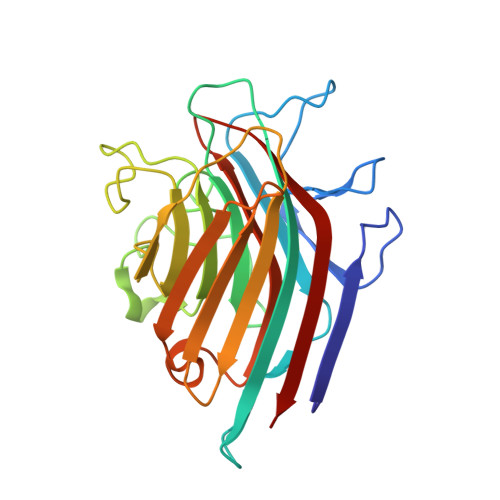Structural studies and nociceptive activity of a native lectin from Platypodium elegans seeds (nPELa).
Cavada, B.S., Araripe, D.A., Silva, I.B., Pinto-Junior, V.R., Osterne, V.J.S., Neco, A.H.B., Laranjeira, E.P.P., Lossio, C.F., Correia, J.L.A., Pires, A.F., Assreuy, A.M.S., Nascimento, K.S.(2018) Int J Biol Macromol 107: 236-246
- PubMed: 28867234
- DOI: https://doi.org/10.1016/j.ijbiomac.2017.08.174
- Primary Citation of Related Structures:
5U38 - PubMed Abstract:
A native lectin (nPELa), purified from seeds of the species Platypodium elegans, Dalbergieae tribe, was crystallized and structurally characterized by X-ray diffraction crystallography and bioinformatics tools. The obtained crystals diffracted to 1.6Å resolution, and nPELa structure were solved through molecular substitution. In addition, nPELa has a metal binding site and a conserved carbohydrate recognition domain (CRD) similar to other Dalbergieae tribe lectins, such as PAL (Pterocarpus angolensis) and CTL (Centrolobium tomentosum). Molecular docking analysis indicated high affinity of this lectin for different mannosides, mainly trimannosides, formed by α-1,3 or α-1,6 glycosidic bond, as evidenced by the obtained scores. In addition, molecular dynamics simulations were performed to demonstrate the structural behavior of nPELa in aqueous solution. In solution, nPELa was highly stable, and structural modifications in its carbohydrate recognition site allowed interaction between the lectin and the different ligands. Different modifications were observed during simulations for each one of the glycans, which included different hydrogen bonds and hydrophobic interactions through changes in the relevant residues. In addition, nPELa was evaluated for its nociceptive activity in mice and was reported to be the first lectin of the Dalbergieae tribe to show CRD-dependent hypernociceptive activity.
- Universidade Federal do Ceará (UFC), Fortaleza, Ceará, Brazil. Electronic address: bscavada@ufc.br.
Organizational Affiliation:




















